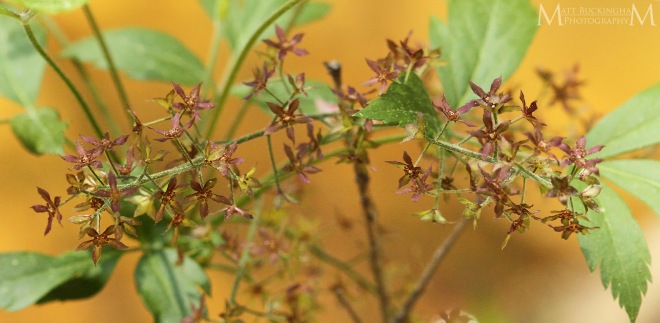Target Species: Yellowroot (Xanthorhiza simplicissima)

Yellowroot
I wasn’t sure that I’d be able to check this one off my list. I first learned that Yellowroot occurred in Texas while looking through Geyata Ajilvsgi’s book Wildflowers of the Big Thicket. I then saw it mentioned in a couple of scientific publications and decided to do a little research. There are very few records from Texas, and those that exist are fairly vague as to the species’ location. Looking at the publications I had an idea where to look, but I had no idea if the plant would be common at that location, easy to see, or when it might bloom. I tried my best to guess the bloom time in East Texas based on the species’ phenology in other states.
A couple of weeks ago I caught a break. While attending the Texas Black Bear Alliance meeting I was chatting with a friend that works for a large timber company who happened to be a naturalist and plant enthusiast. He has access to hundreds of thousands of timber company lands and a penchant for exploring wild places. I casually asked him if he has ever seen yellowroot on timber land, and he said that he had, though he hadn’t seen it in bloom. We talked about getting out to look for it, and finally made it happen yesterday.

County-level distribution of Xanthorhiza simplicissima from http://www.bonap.org
Yellowroot is a subshrub that primarily occurs in the southern Appalachians. There is a disjunct population in East Texas and western Louisiana. Here it is very rare, occurring at only a handful of sites. It’s tiny flowers hang on drooping, branched panicles originating from the main stem. It grows on the banks of small streams that wind through sandy, acidic soils.

Yellowroot Panicles
My friend first took us to a site that I have visited before. We were joined by another friend with a love for the outdoors. We found many plants growing along the margins of a clear, spring fed stream just before it poured from a 20-foot waterfall. Seeing it here, one wouldn’t expect it to be so rare in the state. The sandy stream edge was lined with thousands of plants, many of them in full bloom.

East Texas Waterfall. Photographed in July, 2016.
Yellowroot is so-named for it’s bright yellow roots which contain berberine, an alkaloid with numerous medicinal properties. Native Americans and settlers used Yellowroot as a die and as a cure for a variety of ailments. Yellowroot tea was used to treat sores and other issues in the mouth and gums, congestion, allergies, stomach ulcers, upset stomachs, and indigestion. Crushed roots were used in salves that treated sores, cuts, rashes and swelling. Contemporary research has shown that Yellowroot has the potential to lower blood pressure and improve liver health and function. Advocates of homeopathic remedies still utilize Yellowroot tea as a natural cure-all.

Yellowroot Flowers
Perhaps these medicinal properties helped spell doom for Yellowroot populations in East Texas. It is entirely possible that over collection, along with habitat loss contributed to its current scarcity.
The tiny flowers are really striking, though they require some magnification to appreciate. We saw blooms ranging from brown to purple to greenish yellow. We wandered along the creek for a while enjoying the warm spring air and cold, clean water.

Yellowroot Flower detail
After leaving the falls we traveled to another site where we found Xanthorhiza simplicissima growing in great abundance. This site is also home to a slew of other plants that are exceedingly rare in Texas, including Silky Camelia (Stewartia malacodendron) and Common Serviceberry (Amelanchier arborea).

Typical Yellowroot habitat along a clear, springfed stream.
My friend has a great knowledge of East Texas culture, history, and pre-history. He regaled us with stories of Native Americans and recent residents. It was fitting that while in search of a plant so important to native cultures that we would find an artifact alluding to a time long ago before East Texas was colonized by Europeans. We found this arrowhead along one of the streams we were exploring. Not a day goes by that I don’t long to see the East Texas that the native tribes experienced.

Arrowhead
Before going our separate ways, my friend had one final surprise in store for us. He took us to a relict dating even further back, to a time prior to human habitation, and possibly predating the speciation of Homo sapiens. This ancient palm fossil lies on exposed boulder of the Catahoula formation. It was a fine day spent in fine company. I learned a lot, particularly about the history of the region. I look forward to returning soon to find what other treasures this country is hiding.

